
Mixed Antique and Vintage Copper, Silver, and Enamel Collection
Antique and vintage copper measures, weights, plaque, silver plated cherub stands, obsidian axe head and an unusual enamel compass float bowl, mixed origins and vintages, (13 items), the plaque 46 cm diameter
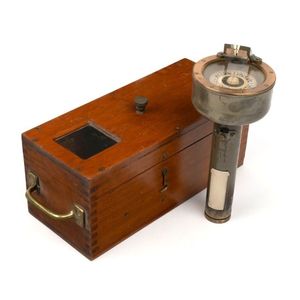
Vintage Hand-Held Maritime Compass in Original Sirius Case
A vintage hand-held maritime compass in original case, stamped 'Trade mark Sirius, E. Esdaile Sydney No.1056', in original timber case, the box 33 cm long

19th Century Surveyor's Hand-held Compass in Timber Case
A surveyor's antique hand-held compass in original timber case, 19th century, the case 15 cm wide

Adams London Double Telescope Theodolite with Central Compass and Levels
A double telescope theodolite by Adams of London, with central compass and two spirit levels, horizontal and vertical scales, an additional spirit level to the top telescope, the top turns to adjust scale by way of the attached brass screw. Tripod absent…

Vintage Nautical Brass Sestral Ship's Compass - Worn Condition
Vintage nautical brass Sestral ship's compass the oil burner for lighting the compass to the side, worn condition, height 23 cm

Antique Brass Ship's Binnacle - 64 cm wide, 115 cm high
Antique brass ship's binnacle no compass or other instruments inside, 64 cm wide, 43 cm deep, 115 cm high
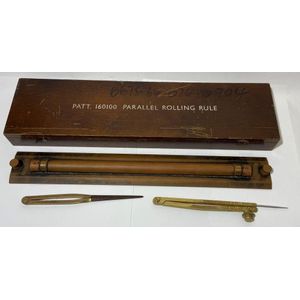
Brass Instrument with Rolling Rule in Fitted Timber Case
Patt.160100 parallel rolling rule, brass instrument in fitted timber case with brass dividers & a compass, case 48 x 12 x 5 cm
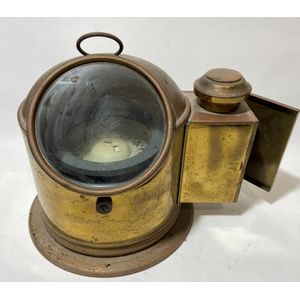
Worn Binnacle Compass with Side Lamp, 21 cm Height
A binnacle compass with side lamp, worn, height 21 cm
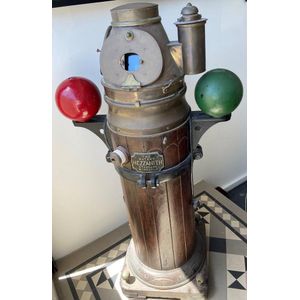
Hezzanith Standard Binnacle with Compass, Ontario Hughes Owens Co Ltd
A Hezzanith standard binnacle with compass, Ontario Hughes Owens Co Ltd, Canada, Patt 0195A, wood with brass fittings, cast iron correcting spheres in red and green, height 135 cm
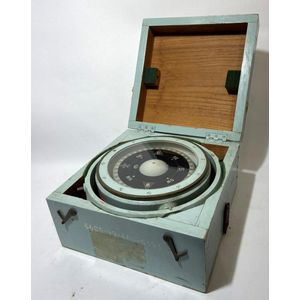
Antique Ship's Compass in Painted Timber Box
A ship's compass, in fitted painted timber box, 27 x 27 x 16 cm
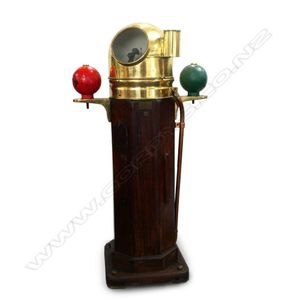
Octagonal Teak Binnacle Compass with Brass Dome and Red/Green Balls
A ship's binnacle compass, octagonal teak case on square plinth base, with brass glazed dome and fittings, flanked by red and green painted steel balls, the Hartmann, Hamburg compass with Lilley & Reynolds, London card, height 150 cm.
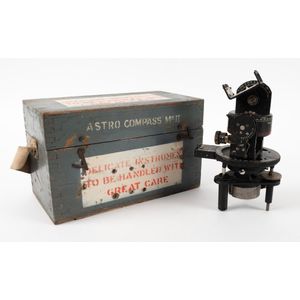
20th Century Astro Compass Mk.II in Original 27cm Housing
Astro compass Mk.II housed in original, 20th century, 27 cm wide

Vintage D.W. Bruntons USA Metal Cased Compass, 7 cm Diameter
Vintage D.W. Bruntons USA metal cased compass marked to lid, diameter 7 cm.
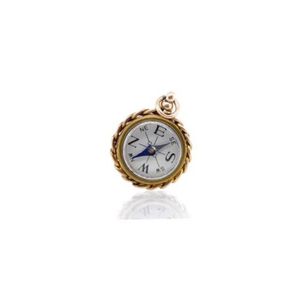
9ct Rose Gold Fob Compass with Missing Back Plate
9ct rose gold novelty fob compass marked Birmingham 9 375 marks, weight 7 grams, missing the back plate, chip to the glass
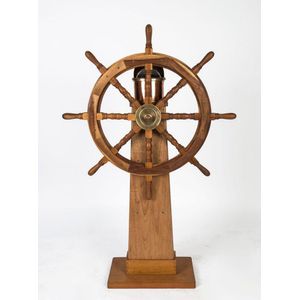
20th Century Ship's Wheel and Compass on Timber Stand
A ship's wheel and wet compass mounted on later timber stand, 20th century, the wheel 92 cm wide, 143 cm high overall
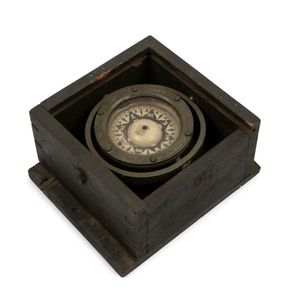
Antique Marine Compass in Original Box
E. Esdaile & Sons, Sydney, N.S.W. A 'Sirius' trademark marine compass with fluid filled brass bowl and fitted gimbal ring, housed in original lidded hardwood box, circa 1910. The box 11 cm high, 21 cm wide, 17 cm deep
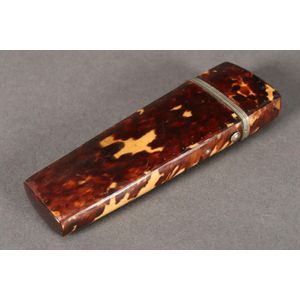
Georgian Tortoiseshell Navigation Set with Silver Plaque
Georgian navigation Necessaire and etui, in tortoiseshell, set with dividers, compass and ivory ruler signed by Schmalcalder, the strand London, the top set with silver plaque and initials, height 13.2 cm

Scientific Instruments Collection in Original Boxes
A collection of five Scientific instruments, a boxed aneroid barometer, an Alidade level, box sextant, Esdaile compass and a pair of draughtman's dividers. All in the original boxes or hard leather case. (5)
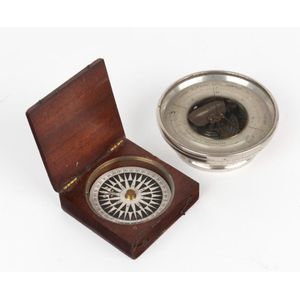
Nickel Barometer, Thermometer & Compass Set, 1900
A nickel cased barometer/thermometer, together with a boxed compass, circa 1900, 100 cm diameter and smaller. Provenance: Property from the collection of George Gyori, Melbourne
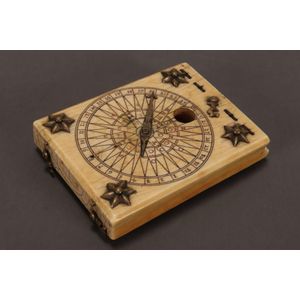
1600 Ivory and Brass Sundial Compass by Paulus Reinman
Early 17th century ivory and brass sundial compass by Paulus Reinman, Nuremberg, dated 1600, diptych, of rectangular form with a hinged cover, with various incised and inked dials and depictions of the star signs, with brass hinges, latches and stars set…

French Silver Pocket Sun Dial with Compass and Gnomon
French silver pocket sun dial, by Baradelle, Paris, France, c. 1701-1750, of octagonal shape, inset with compass, engraved with hour scales for latitudes 43° to 52°, folding bird gnomon, the reverse engraved with the latitudes of French and other…
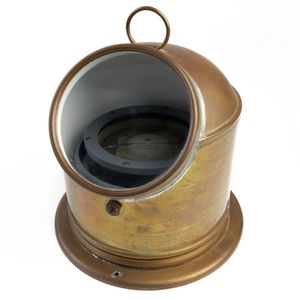
Vintage English Sestrel Maritime Gimbal Compass in Brass Case
Vintage English Sestrel maritime gimbal compass in brass case, height 25 cm

Vintage Collectables Set
Four vintage miscellaneous collectable pieces including: cased pair rolled gold spectacle frames; an antler horn handle pocket knife; brass cased compass; and a brass feather form letter opener.

Vintage Brass Prismatic Compass Set
Two vintage brass cased prismatic compasses, including: leather cased brass compass, marked for Alfred Gillott, and a leather cased brass compass, marked Verner's pattern, diameter 5 cm each.

19th Century Ship's Binnacle with Compass
A vintage ship's binnacle with compass,19th century, 57 cm high, 71 cm wide, 40 cm deep

Pair of Rare Brass Pocket Sundials with Compass and Calendar
Ansonia: two rare brass cased pocket sundials with wax card compass and perpetual calendar printed to the case lid, early 20th century, one with leather carrying case. (2 items). The leather case 10 cm long.

19th Century Wardale Pocket Compass in Original Case
An antique pocket compass by J. Wardale & Co. In original case, 19th century.
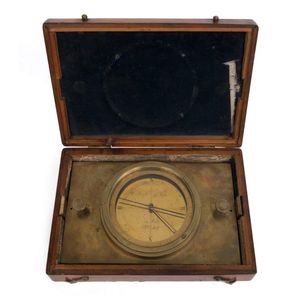
Antique Austrian Brass Sighting Compass in Wooden Box
An antique Austrian brass sighting compass in wooden travelling box, 19th century, engraved 'E. Krafp & Sohne, in Wein, no. 318', the dial 10 cm diameter

Dollond of London Sighting Compass in Mahogany Case
Dollond of London travelling sighting compass mounted in original mahogany case, early 19th century, the silvered dial 13 cm diameter

Barker & Son Prismatic Compass with Leather Case
Barker & Son mark IX prismatic compass with mother of pearl dial and leather case

Bruntons Pocket Transit Compass (1894)
D. W. Bruntons 1894 patent pocket Transit compass by Wm Ainsworth & Sons, Denver, Colorado, USA.
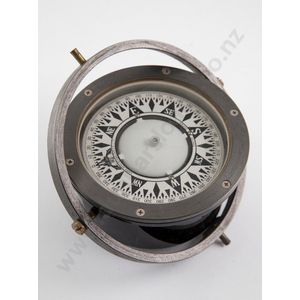
Saura Keiki Seisakusho Co Ltd Ship Compass
Ships compass by Saura Keiki Seisakusho Co Ltd Tokyo Japan 15.5 cm dia

E.R. Watts & Son Ltd Japanned Prismatic Compass + Case
Cwwi Japanned prismatic compass by E. R. Watts & Son Ltd, London, with leather carrying case

Golden Compass Jewelry Set
A gold plated compass pendant, together on gold plated chain, single earrings and pendant.

1860 Mariners Compass in Gimbals and Timber Box
Mariners compass circa 1860 dry card compass in a copper bowl mounted in Gimbals in a timber box Fleur de Lys on the north point boxed, height 11 cm, length 16 cm, depth 16 cm
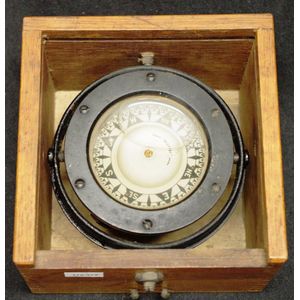
Wooden case maritime compass, 9cm diameter
'Sestrel' maritime compass in wood case, missing lid, etc., diameter 9 cm compass.
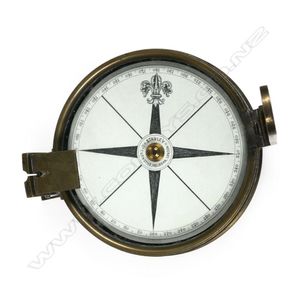
Brass Sighting Compass from Stanley, London
A 4-inch brass cased sighting compass, with card marked Stanley Gt. Turnstile, Holborn, London.

Rare Bagnold Sun Compass used by LRDG in WWII
An exceptionally rare and important Bagnold sun compass, Instrumental in giving what has become one of Britain's most famous special forces. The Long Range Desert Group, an unrivalled edge in the North African desert during World War II it is believed…

Antique Brass Theodolite with Swivel Base and Compass
Antique brass theodolite, brass mounted swivel base with central mounted compass

Octagonal Teak Binnacle Compass by Hartmann, Hamburg
A good ship's binnacle compass, octagonal teak case on square plinth base, with brass glazed dome and fittings, flanked by red and green painted steel balls, the Hartmann, Hamburg compass with Lilley & Reynolds, London card. H.150 cm.
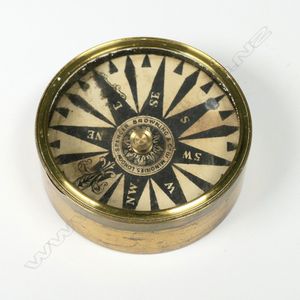
Antique Brass Pocket Compass by Spencer Browning & Co
A lacquered brass 3 inch pocket compass, the card marked 'Spencer, Browning & Co, Minories, London' (1840-70), with press fit cover. Provenance: The H.N.E Sheppard Estate Collection.

1912 Kelvin & James White Ltd Compass with Testing Certificate
A Kelvin & James White Ltd 8 inch compass card, with testing certificate from the Magnetic Observatory, Glasgow, dated 1912, uninstalled, in transit box with glazed cover replacing the lid. Provenance: The H.N.E Sheppard Estate Collection.

Brass compass clock, 30cm diameter, untested
Brass ships compass Convert to clock with enamel, diameter 30 cm, untested
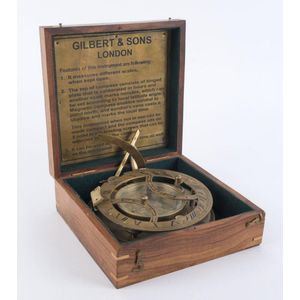
Brass Sundial Compass in Timber Case, 20th Century
Gilbert & Sons London, brass sundial compass in timber case, 20th century, 19 cm diameter
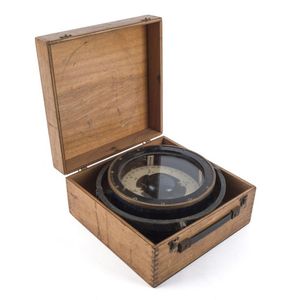
Baker Lyman & Co Binnacle Compass in Original Box
A ship's binnacle compass in original box by Baker Lyman & Co, 30 cm diameter

Naval Brass Folding Pocket Compass with Natural Sine Scale
A naval brass folding pocket compass, the hinged lid with 'Natural Sine' scale, working.

Negretti & Lambra Pocket Barometer/Compass
A c.1900 Negretti & Lambra compensated pocket barometer/compass, the dark red Morocco leather fitted case enclosing the circular brass framed instrument, the case back fitted with a visible compass. Case, diameter 5.8 cm.
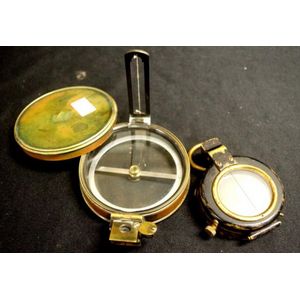
Vintage Compass Set in Leather Cases
Two various vintage compasses including brass cased, marked for Short and Mason, in leather carry case; and another compass, unmarked, in leather carry case.

Brass Sighting Compass with Sun Filters
A brass cased sighting compass, with green card scale, the sight with coloured glass sun filters, diameter 10 cm.

Sydney Transit Compass with Leather Case
T.F Wiesener, Sydney Transit compass, with green circular dial, gunmetal surrounds, circular cover and leather travel case,

Copper Ship Compass by John E. Hand & Sons
A copper cased ships compass by John E. Hand & Sons 58 cm high, 210 cm diameter

Brass and timber ships binnacle with compass and clinometer
Brass and timber ships binnacle, of cylindrical form set with small door, with brass housing enclosing the binnacle compass inscribed 'Iver C. Weilbach & Co. Copenhagen,' with clinometer, flanked by red and green iron navigator balls, height 116 cm

Spanish Brass Ship Compass in Walnut Box, 20th Century
A Spanish brass framed ships compass in original walnut box, early 20th century. 20 cm high, 31 cm wide

English Mahogany Ships Binnacle with Compass
Heath & Co English mahogany and brass ships binnacle, London, Patrol Type No. 875, with compass, the whole in weathered condition, 138 cm high

Vintage Sestrel Hand Bearing Compass by Henry Browne & Son
Case vintage 'Sestrel' marine hand bearing compass, marked for Henry Browne & Son Ltd, Barking and London. Untested, but appears operational, height 31 cm (case).

Saur Ship's Binnacle Compass
An old silver-plated ship's binnacle compass, by Saur, Japan, with fixed handle. Height 27 cm

Damaged 9ct Gold Masonic Swivel Compass - 6g
9ct gold, Masonic swivel compass, (needs repair), weight approx 6 grams
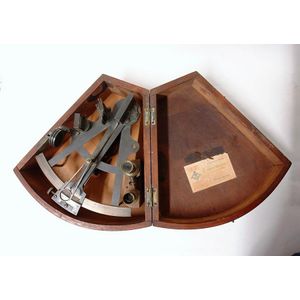
Victorian Brass Sextant with Mahogany Case
A Victorian brass sextant, various lenses and filters, the mahogany case with label to interior for John Bruce of Liverpool 'Compass Adjuster'.

Brass and Copper Binnacle Compass Cover (No Compass)
A ships binnacle, compass cover - (lacking compass) brass and copper construction height 117 cm

French Vintage Ship Compass Binnacle, 140cm High
Vintage French ships compass binnacle, painted white, 140 cm high

Japanese Ship Compass by Saura Keiki Seisakuri Co Ltd
Saura Keiki Seisakuri Co Ltd, Japanese ships compass
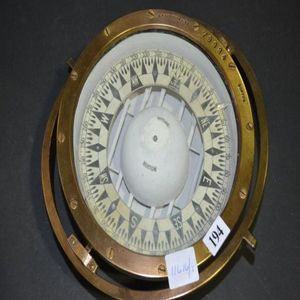
Ritchie's 19th Century American Ship Compass
Late 19th century American ship's compass by Ritchie of Boston, Mass. (with information)
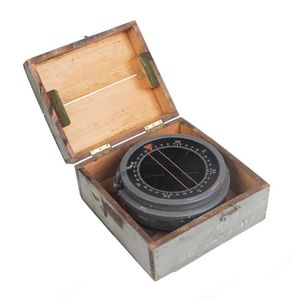
1930 Ship Compass with Admiralty Observatory Stamp
A ships compass (Type P4) in timber case with Admiralty Compass Observatory Examination stamp, 20th February 1930. 18.5 cm diameter.
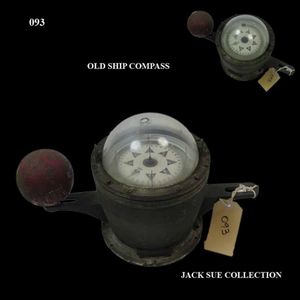
Antique Marine Compass by Henry Browne & Son
An early marine ships compass, by Henry Browne & Son, Barking, London, with 'Sestral' Trademark marked on dial brass and metal mounts; working condition. It is believed that this item was part of a salvage contract conducted by JACK SUE WA SKINDIVERS in…

Z Special Unit's Standby Compass
Jack Sue's standby compass. One of the standby compass types as used by members of Z special Unit during Operation Agas behind Japanese lines in the then British north Borneo in 1945. This compass was used in conjunction with the personal field compass.…
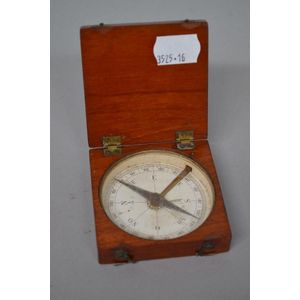
19th Century Pocket Compass - Antique Square Design
Antique 19th century pocket compass, approx 7 cm square
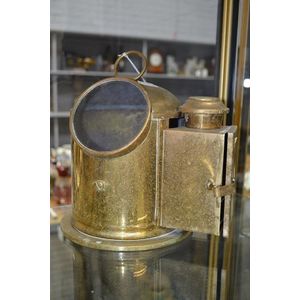
George Wilson Gimble Compass with Side Light
George Wilson London, brass cased gimble compass and side light, approx 24 cm high, 21 cm long
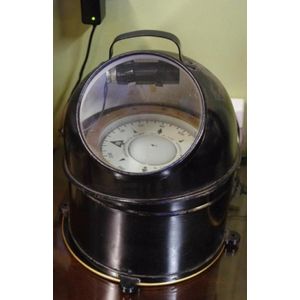
Wagner Auto Pilot Maritime Binnacle with Compass
Maritime binnacle with compass, by Wagner Auto Pilot, Canada, 24 cm high approx
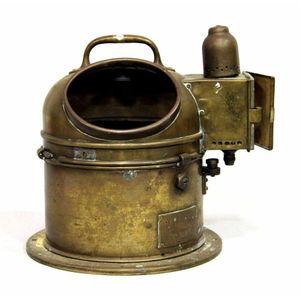
Vintage Brass Ship's Binnacle with Gimbal Compass and Light
A vintage brass ship's binnacle with an internal gimbal mounted compass and small electrical side light. No.11085K. Height 25 cm. Depth 25 cm

Brass Stanley Prismatic Compass with Damaged Glass Dial
Stanley prismatic compass all brass with steel dial (glass damaged)

19th Century Brass Marching Compass
A brass cased marching compass, 19th century, with pivoted card scale printed with mirrored numerals, the press cover designed to fit to the base. Diameter 10 cm

Type 06 Hand-Held Sighting Compass in Wooden Case
A ship's hand-held sighting compass in wooden case marked 'Type 06', 22 cm high

Steinhoft German Ship Compass with Instruments and Oak Case
Steinhoft German ships compass with instruments, in an oak case, plaque engraved 'Presented to E.J. Smith Captain of RMS Celtic, January 31st 1890'. Dimensions 27 x 27 x 18.5 cm

English Oak Ship Wheel Stand with Brass Fittings
A vintage English oak sailing Ship wheel stand tapering cylinder shaped with brass topped compass binnacle fitting and various brass plaques and signs of nautical theme. Height 13 cm

Vintage Brass Binnacle Compass with Pedestal Base
A vintage free standing brass binnacle compass with pedestal column base containing a more recent compass. Height 115 cm

Binnacle Compass with Side Lamp
Deck compass in binnacle, with oil lamp side illuminator. Height 23 cm
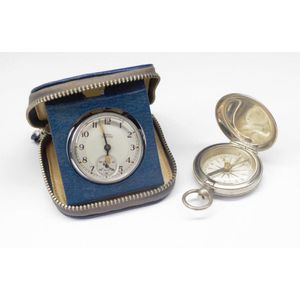
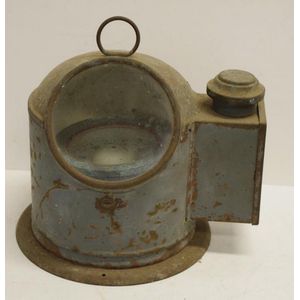
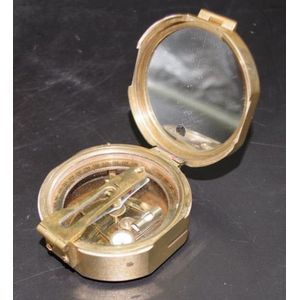




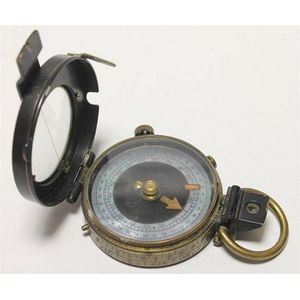


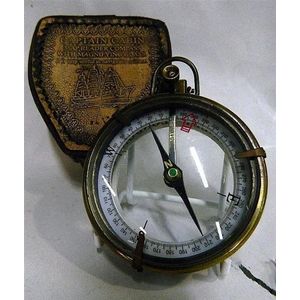



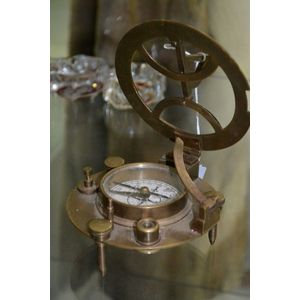
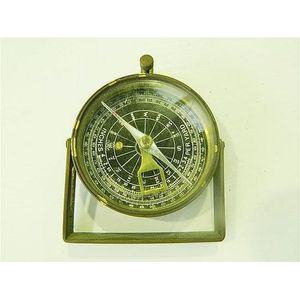
 Loading more...
Loading more...